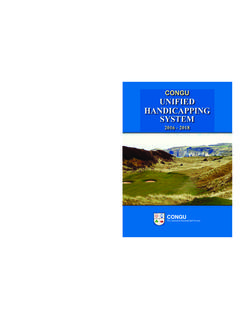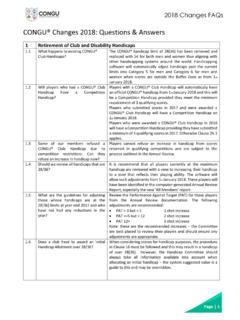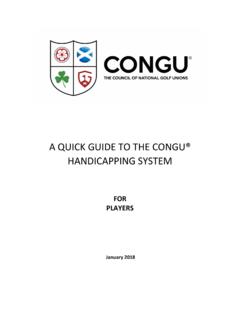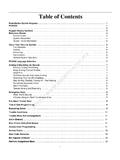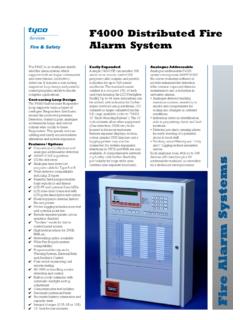Transcription of A QUICK GUIDE TO THE CONGU HANDICAPPING …
1 A QUICK GUIDE TO THE CONGU HANDICAPPING system FOR PLAYERS January 2016 2 A QUICK GUIDE to the CONGU HANDICAPPING system (January 2016) INTRODUCTION Unlike many other sports, golf has a HANDICAPPING system that allows players of very different abilities to play against one another in a fair and equitable way. This is one of the reasons for golf s popularity! Broadly speaking, your handicap is the additional number of shots you would take on a slightly better than average round compared with a scratch player (someone whose handicap is 0). As a player, you have the responsibility to play off the correct handicap. This is not as difficult as it might seem if you take a short time to understand the CONGU system . All the words and phrases in bold in this GUIDE are explained in the Glossary at the end.
2 There are other words and phrases in the Glossary that you will also find useful. GETTING STARTED If you are a member of a club that is affiliated to one of the home unions (ie, the governing body for golf in England, Ireland, Scotland or Wales), then you are eligible to have a CONGU handicap. To get your first handicap you will need to complete 54 holes of golf (this may be any combination of 18- and 9-holes*) with your card marked by someone who understands the Rules of Golf. (Whoever is in charge of golf at your club this may be the manager, the professional, the captain, a committee member or another member - will advise you who can mark your card and also tell you which tees you must play from.) Once your rounds are completed the handicap committee will consider the scores you have made and, taking into account any previous golfing experience you may have had as well as any other sporting achievements, will allot you a handicap.
3 Now, every time you play in a qualifying competition your handicap may go up or down. *Many clubs have a designated 9-hole course. You cannot play any 9-holes; you must play the specified holes. 9-hole scores are added together chronologically to create an 18 hole score. HANDICAP CATEGORIES Handicaps are divided into different bands called categories. Depending on which category you are in, the amount your handicap can go down varies. Also the amount you can play over your handicap (called buffer zone) varies before your handicap increases. Category Handicap bands Buffer zone Handicap decreases for every shot below CSS 1 Plus - 1 shot above CSS 2 2 shots above CSS 3 3 shots above CSS 4 4 shots above CSS 5* 5 shots above CSS Club handicap 29**/37** - 54 5 shots above SSS or *This handicap band is for women only **Men s club handicaps start at 29; women s at 37 NB If you have a club handicap you must check which club competitions you are eligible to enter Everyone s handicap is calculated to 1 decimal place but their playing handicap is the nearest whole number.
4 For example, Joe s exact handicap is and his playing handicap is 22. Rajiv s exact handicap is so his playing handicap is 11. 3 A QUICK GUIDE to the CONGU HANDICAPPING system (January 2016) MANAGING YOUR HANDICAP After any qualifying competition or supplementary score your handicap may change. If you play below your handicap, your handicap will be reduced by a certain decimal point for every shot under (see table above). If you play above your handicap, your handicap will be increased by You are allowed some leeway (this is your buffer zone see table above for different buffer zones), but once you are above your buffer zone, your handicap goes up. You may be 1 outside your buffer or 10 outside your buffer, the result is the same: your handicap increases by COMPETITION PLAY It is usual that any stroke play competition played off full handicap results in handicap changes.
5 No-one is expected to be able to play to their handicap for every round. There is some flexibility: if you play within your buffer zone your handicap will not alter. In fact, handicaps are so calculated you are likely to play within your buffer zone for only one third of your rounds. Joe has a handicap of 22 (Cat. 4) and plays 3 shots over his handicap. His handicap does not change. Jill has a handicap of 3 (Cat. 1) and plays 3 shots over her handicap. Her handicap goes up Standard scratch score (SSS) v competition scratch score (CSS) Every course has a standard scratch score (SSS). It is a fixed figure and will be printed on your club s score cards: it may be different from par and it is likely to be different for men and women and from different tees. For example, at Belle View Golf Club the par from all tees is 71 for men and 72 for women.
6 However, the SSS for men from the White tees is 71 and from the Yellow is 70 and for women playing from the Red tees the SSS is 72. After every qualifying competition a competition scratch score (CSS) is calculated. This number can vary because weather conditions may make the game more or less difficult; pin positions may make the course more or less difficult. The CSS takes account of these factors and is calculated on the percentage of players within or below their buffer zone. CSS can range from 1 lower than SSS to 3 higher. On very bad days it might be that a competition becomes reduction only . That is, no-one s handicap increases although those below CSS decrease. On a cold, wet and windy Sunday the men at Belle View Golf Club played their monthly medal. Only 6 players were within their buffer zone.
7 The CSS moved from71 to 73. Joe who had done a nett 76 (and thought he was 1 above his buffer) found he was now within buffer. A month later in the next medal, the sun shone and the greenkeeper had some friendly pin positions. Nearly everyone played well and the CSS came down to 70. In the good conditions Rajiv did a nett 73. However, because the CSS had come down, Rajiv was out of his buffer zone and his handicap went up to NB Players with club handicaps, even in competitions, always measure their scores against the SSS of the course played rather than the CSS. Nett double bogey score in medals If you are playing a medal competition and have a horrendous score on one hole .. although this score is counted for the purposes of the competition, it is not for handicap. For handicap, the worst score that is counted is the equivalent of the lowest score that would not give you a point in a stableford competition.
8 Joe (still playing off 22) scores 9 on the par 4, stroke index 4 hole in the monthly medal. If he were playing a stableford, Joe would get 2 strokes on this hole, so he could make a 7 (nett 5) and still score a point. The lowest score where he does not make a point would be 8. So, for handicap purposes, Joe s score is reduced to 8. 4 A QUICK GUIDE to the CONGU HANDICAPPING system (January 2016) Joe scores another 9 this time on the par 3, stroke index 17 hole. If he were playing a stableford he would only get 1 stroke here so he could make a 5 (nett 4) and score 1 point. So the lowest score not to make a point is 6. Joe s 9 is reduced to 6. Although Joe s medal round is recorded as 100, nett 78 after the nett double bogey reductions for handicap this comes down to nett 74 inside his buffer zone, so his handicap is not altered.
9 Returning your card/ no return When you and your playing partner have finished your round in a competition, you should check that your card is completed properly. Is your name printed legibly? (A courtesy for those who have to check your card) Are your scores written legibly? Have you written in the name of the competition? (There may be more than one running) Is the date there? Is your correct handicap on the card?* Has your marker signed the card?* Have you signed the card?* *Part of the Rules of Golf if you haven t done this you will be disqualified from the competition although your score will still count for handicap purposes Most clubs will require you to enter your score into the computer through the PSI (personal score input) system . This should be as much part of your routine as holing the last putt on the 18th.
10 Not having enough time is not a valid excuse! Having entered your card, remember to put it in the right place for completed score cards. (It is possible your club will have sanctions it can impose on people who consistently fail to enter their score on the club s computer or indeed fail to return their score card to the designated place.) Every time you compete in a competition you should return your card. This is firstly so the competition organiser knows that you have played in the competition and secondly because the organiser may want to check your marker s score which is on your card. It is against the spirit of the game to put your poor score card in your pocket and drive home. However, there are two occasions when, from the perspective of the competition, your returned card will be classed as a no return.
